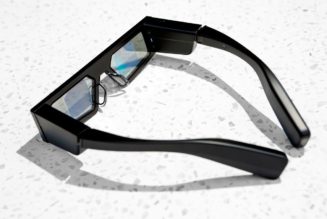The OnePlus 9 Pro is a legitimate flagship phone that is genuinely competitive with the best Android phones on the market — at least from a features and quality perspective. Yet in terms of market and mind share, it’s still destined to be a niche device for a small group of enthusiasts looking for a specific kind of elegance in their Android device.
And that’s great.
If you live in the US and you’re buying an Android phone, chances are very high that you’ll end up with a Samsung Galaxy phone. Samsung has the carrier relationships, quality, and marketing that have led directly to market share. LG, Motorola, and even Google sell more phones here than OnePlus does.
But after nearly seven years and dozens of phones, OnePlus has established itself as a brand that can make great phones that are serious alternatives to the mainstream. The $969 OnePlus 9 Pro achieves that goal with only a handful of notable compromises.
OnePlus’ flagship phones always come with a laundry list of top-of-the-line specs, but what makes the OnePlus 9 Pro good isn’t the numbers; it’s how well those specs translate into one of the best experiences you can get using Android.
:no_upscale()/cdn.vox-cdn.com/uploads/chorus_asset/file/22388892/bfarsace_4481_20210317_0068.jpg)
OnePlus 9 Pro hardware design and 5G support
The hardware design on the OnePlus 9 Pro is the most seamless, elegant phone that the company has designed to date. It is, of course, big. It has a 6.7-inch screen that goes from edge to edge in a body that’s narrow enough to make it just barely usable for me in one hand.
What I can’t help but notice is how far OnePlus has come in build quality. The glass on the front and back curves into the aluminum rail on the edges with no seams at all. It’s well-balanced, beautiful, and solid.
:no_upscale()/cdn.vox-cdn.com/uploads/chorus_asset/file/22389264/oneplus9progalaxys20plus.png)
:no_upscale()/cdn.vox-cdn.com/uploads/chorus_asset/file/22388880/bfarsace_4481_20210317_0054_Edit.jpg)
It’s also the spitting image of a Galaxy S20 Plus. Shift a couple of buttons around, move the selfie camera to the middle, and swap out the logo, and it’s the same design. I get that there are only so many ways to sandwich curved glass and aluminum together, but it’s uncanny.
To be fair, OnePlus does keep some of its identity in the three-stage ringer switch, which easily lets you toggle between a ringer, vibration, and fully silent. It may still be my favorite feature on OnePlus phones, and I remain baffled as to why more Android phone makers don’t adopt a physical ringer switch.
Speaking of vibration, the haptics on the OnePlus 9 Pro aren’t sloppy at all, unlike many Android phones. Unfortunately, the trade-off is that they aren’t very strong; I often can’t feel it vibrate in my pocket.
The OnePlus 9 Pro has the top-tier Qualcomm Snapdragon 888 processor, which is paired with eight gigs of RAM on the 128GB model. You can’t get it in a smaller screen size, but you can spend $100 more to get 256GB of storage and 12GB of RAM. There’s no microSD card slot for storage expansion in either model. What you get is what you get.
It supports both Sub-6 and millimeter-wave (mmWave) styles of 5G, but there’s a significant caveat: the phone supports it, but OnePlus has only managed to land 5G certification from its carrier partner, T-Mobile. If you buy it unlocked, as of now, it will only work with T-Mobile’s 5G network. Everything else will be LTE. AT&T 5G support doesn’t appear to be in the cards at all, and as for Verizon, OnePlus says that it “continues to work with Verizon to certify both the 9 and 9 Pro on its 5G network.” Later, on March 26th, Verizon announced that it would support 5G on the OnePlus 9 and 9 Pro.
:no_upscale()/cdn.vox-cdn.com/uploads/chorus_asset/file/22388875/bfarsace_4481_20210317_0047.jpg)
OnePlus 9 Pro battery and charging
For OnePlus, the standout spec is its proprietary charging technology. There’s a 65W charger included in the box, and it can charge up the phone ridiculously fast. The phone’s 4,500mAh battery is actually split in two, which helps further speed charging.
:no_upscale()/cdn.vox-cdn.com/uploads/chorus_asset/file/22388874/bfarsace_4481_20210317_0044.jpg)
If you like, you can spend an additional $69 on OnePlus’ new Warp Charge 50 wireless charger. It charges at 25W, but since the battery is split, it’s essentially the same as charging at 50W, wirelessly. It also works if you set the phone on the charger in landscape mode. With the phone fully dead, it charged completely in 45 minutes. With ambient mode in Google Assistant on, it took a bit longer — but it was still wicked fast compared to other wireless chargers.
That 4,500mAh battery was enough to get me through a full day and a half of moderately heavy usage. However, OnePlus phones do tend to be a little more variable in their battery life depending on use. Spending a day shooting 4K video and pushing the processor with games meant I could kill it with less than four hours of screen-on time.
So while the battery life might not be best in class, the way OnePlus has built its ecosystem for charging means I’m able to top off faster than I can with other phones — provided I use OnePlus’ proprietary chargers, of course.
:no_upscale()/cdn.vox-cdn.com/uploads/chorus_asset/file/22388890/bfarsace_4481_20210317_0066.jpg)
OnePlus 9 Pro screen
After wireless charging, the next standout spec on the OnePlus 9 Pro is that 6.7-inch screen. Like Samsung, OnePlus has switched over to an LTPO style of OLED, which can be more power efficient and allows the company to have more control over the refresh rate.
The screen can go all the way from 120Hz on down to 1Hz, depending on what’s happening on the display. OnePlus has branded the touch response rate on the screen as “Hyper Touch,” clocked at 360Hz for certain games, and though I am dubious it makes that big a difference for gamers, OnePlus says it could. More consequential is the screen resolution: 1440 x 3216 at 525ppi. You can leave it at that high resolution and have the high refresh rate screen going at the same time. Doing so probably hits battery life, but to me, the point of this max-spec phone is to max the specs, so I didn’t turn down the resolution or the refresh rate.
Those are the specs on the screen, but it’s the experience that matters. And again, I think OnePlus has done a remarkable job here. Something about the tuning of the animations in OxygenOS makes this phone feel just a little bit smoother than even Samsung phones. I also appreciate the color tuning — although it’s not as subdued as an iPhone or even a Pixel, it’s more restrained than Samsung’s default settings.
:no_upscale()/cdn.vox-cdn.com/uploads/chorus_asset/file/22388879/bfarsace_4481_20210317_0053_Edit_1.jpg)
OnePlus 9 Pro camera
Without delving into a lot of history, I will just point out that until very recently, camera quality has been the main downfall for OnePlus phones. It’s a particularly bad way to fall down, too, because often, the clearest and simplest way to compare phones that otherwise look and perform nearly equivalently is to look at the photos they take.
OnePlus knows all of this and wants to position the OnePlus 9 Pro as a heads-up competitor — or at least a viable alternative — to the very best Samsung and even Apple have to offer. So it did a thing a lot of challenger brands do: called in a ringer.
That ringer is Hasselblad, which OnePlus is partnering with to improve its camera results. It will be a multiyear effort, and it’s far from guaranteed it’ll be a fruitful partnership. In fact, most of these sorts of deals don’t really do anything notable when it comes to the camera’s quality.
This year, Hasselblad’s participation with OnePlus’ development process amounted to helping the company tune the colors from the camera and lending a bit of its interface to the camera’s Pro mode. Oh, and most importantly for OnePlus, Hasselblad allowed its logo to be stamped next to the lenses.
I do think there’s some credit due to this color-tuning influence. In the same way that other smartphone brands have a “look” to their photos, I think OnePlus is developing its own. iPhone photos are generally flat and neutral, tending to the warm side of color; Pixel photos contrasty and blue; and Samsung photos have the vibrancy slider set to max.
:no_upscale()/cdn.vox-cdn.com/uploads/chorus_asset/file/22389337/17_LE2125_IMG_20210313_111817.jpg)
:no_upscale()/cdn.vox-cdn.com/uploads/chorus_asset/file/22389338/20_LE2125_IMG_20210313_113526.jpg)
:no_upscale()/cdn.vox-cdn.com/uploads/chorus_asset/file/22389336/15_LE2125_IMG_20210313_110553.jpg)
The OnePlus 9 Pro’s image output lands mostly in the middle. It tends toward blue, and it definitely lifts up shadows to create more even lighting. Its photos are more striking but less accurate than what you’ll get out of an iPhone.
The camera system is good, but it can’t quite match the quality you get from an iPhone 12 Pro Max or Samsung Galaxy S21 Ultra — both of which cost more than the OnePlus 9 Pro. It handles a variety of conditions quite well, but sometimes I just had to take an extra beat to compose my shot. It let me better judge what the viewfinder was showing and, honestly, gave me time to try the shot again.
As usual with smartphone cameras, I think the difference comes down to software. I like the colors the 9 Pro produces, but sometimes it just tries too hard and whiffs. Similarly, OnePlus seems to want to bring a little of that Pixel contrast magic to bear but instead just oversharpens. And lightening shadows is sometimes laudable, but not when it adds completely unnecessary and distracting image noise.
:no_upscale()/cdn.vox-cdn.com/uploads/chorus_asset/file/22389355/18_LE2125_IMG_20210313_112304.jpg)
:no_upscale()/cdn.vox-cdn.com/uploads/chorus_asset/file/22389354/06_LE2125_IMG_20210311_160459.jpg)
The main camera uses a new 48-megapixel Sony sensor with OIS, though when I pressed OnePlus to tell me what exactly that sensor brings to the table, I didn’t really get a clear answer. You can shoot 12-bit RAW images in the Pro mode (which is two bits more than last year, if you’re keeping count).
That’s all nice, but the interface on Pro mode is what gets me. You can clearly see what’s set to manual and what’s in auto mode. It’s simple and easy to use, too. Best of all is focus peaking, which draws little lines over the part of the image that’s in focus. It is a lot clearer and more fun to use than the tap-to-focus you need to use on other phones. (You can do that here, too, of course.)
The OnePlus 9 Pro’s other cameras include a big, 50-megapixel ultrawide with a sensor that’s quite a lot nicer than the usual step-down sensors ultrawides get stuck with. I loved using it right up until it went haywire with sharpening. OnePlus put in a custom lens to help with distortion at the edges, and it works as well or better than pure software fixes at keeping straight lines from bowing.
The telephoto camera is 3.3x, and it’s not anything special at that zoom level. Beyond it, digital zoom is kind of a mess. It gets pantsed by the S21 Ultra with its periscope-style lens. There’s also a monochrome camera that serves only as a helper for the rest of the system, but I suspect it’s not doing anything especially important. OnePlus did drop the gimmicky and pointless “color filter” camera from last year’s 8 Pro this time around. It will probably drop the monochrome camera next year, if I had to guess.
OnePlus’ software-focused Nightscape mode works really well for capturing nighttime shots, although to my tastes, it over-brightens the image. Portrait mode is a mixed bag; heads often look artificially cut out from the blurry background. Again, I can get good shots, but portrait mode was often one of those situations where I needed to try the shot a second time. The selfie camera is passable in good light but falls down fast in the dark.
Unfortunately, video is equally messy. The OnePlus 9 Pro will let you shoot up to 8K 30 or 4K 120, but neither looked good. In fact, regular old 4K 30 has that overprocessed and oversharpened look you see so often from smartphones. The big new feature is improved HDR for backlit subjects, but the effect is minimal at best.
That’s a whole pile of critical takes compared to phones that cost more than this phone. But despite the price difference, I think the OnePlus 9 Pro’s camera should be held to as high a standard as possible — it’s a flagship phone. It can sometimes hang with the best of the best, and that’s a win.
:no_upscale()/cdn.vox-cdn.com/uploads/chorus_asset/file/22388878/bfarsace_4481_20210317_0052_Edit.jpg)
OnePlus 9 Pro performance and OxygenOS 11
Even though the camera is often the main differentiator for an Android phone, it’s not necessarily everybody’s highest priority. When I’m not pixel-peeping photos, the OnePlus 9 Pro is the best Android phone I’ve used so far this year. The performance is great. I’m especially impressed with the optical in-screen fingerprint sensor, which is super fast and doesn’t seem to be thrown by weird lighting conditions.
OnePlus’ version of Android is called OxygenOS, and it’s now at version 11. The company has borrowed Samsung’s idea of shifting content down to meet your thumb and added in support for an always-on ambient display. The animations feel smooth, and OnePlus has learned its lesson about how annoying it can be to have apps close in the background too often.
OnePlus has committed to two major OS updates and three years of bimonthly security updates, which puts it ahead of brands like LG but behind Samsung and Google.
You can customize a few things like the font and icons, too. My favorite customization is an ambient display mode that displays a colorful bar that shows how often you’ve been using your phone throughout the day.
One feature borrowed from Apple and / or Microsoft is the ability to put your widgets into a separate panel so they’re not littering your main home screen, accessible via a quick swipe down. I love it, but I wish it wasn’t mapped to the same thing other Android phones use to quickly bring down notifications.
Mostly, though, OxygenOS just feels chill, especially compared to Samsung. OnePlus isn’t pushing its own ecosystem of apps and services (though with a new OnePlus Watch coming, perhaps that may change). It’s also not festooning its own apps with advertisements, unlike Samsung.
:no_upscale()/cdn.vox-cdn.com/uploads/chorus_asset/file/22388899/vpavic_4481_20210311_0003.jpg)
:no_upscale()/cdn.vox-cdn.com/uploads/chorus_asset/file/22388886/bfarsace_4481_20210317_0061_Edit.jpg)
:no_upscale()/cdn.vox-cdn.com/uploads/chorus_asset/file/22388898/bfarsace_4481_20210317_0077_Edit.jpg)
The OnePlus 9 Pro is not a “flagship killer.” It’s a flagship. Although it still costs a little less than its top-tier competitors, it nevertheless is a pricey phone that makes a lot of promises. Mostly, it delivers on them. Even though a tiny fraction of customers buy OnePlus phones compared to Apple and Samsung, the company has built a track record long enough to deserve its status as an established brand.
If you’re considering one of the new OnePlus phones, I am actually hard-pressed to make the case for the OnePlus 9 Pro over the regular OnePlus 9, which Allison Johnson reviewed. The regular OnePlus 9 is $240 less, and the things you lose are mostly the nice-to-haves that justify the Pro’s existence: fast wireless charging, OIS, a telephoto lens, mmWave 5G, and the slightly larger screen. The cheaper OnePlus 9 lacks telephoto, but its other cameras take photos that are nearly equivalent to the pro. It has a high refresh rate screen, fast wired charging, wireless charging (though it’s not as fast), and most importantly, a nice OnePlus software experience with great performance.
The reason to opt for the 9 Pro over the regular 9 is in some ways the same reason you’d opt for a OnePlus phone over a Samsung phone in the first place: it’s just a little nicer and a little different than what everybody else has in their pocket.
Update March 26th, 2021 5pm ET: Verizon announced it would support 5G on the OnePlus 9 and 9 Pro and OnePlus confirmed they will not work on AT&T’s 5G network. The review has been updated to note the new information.














